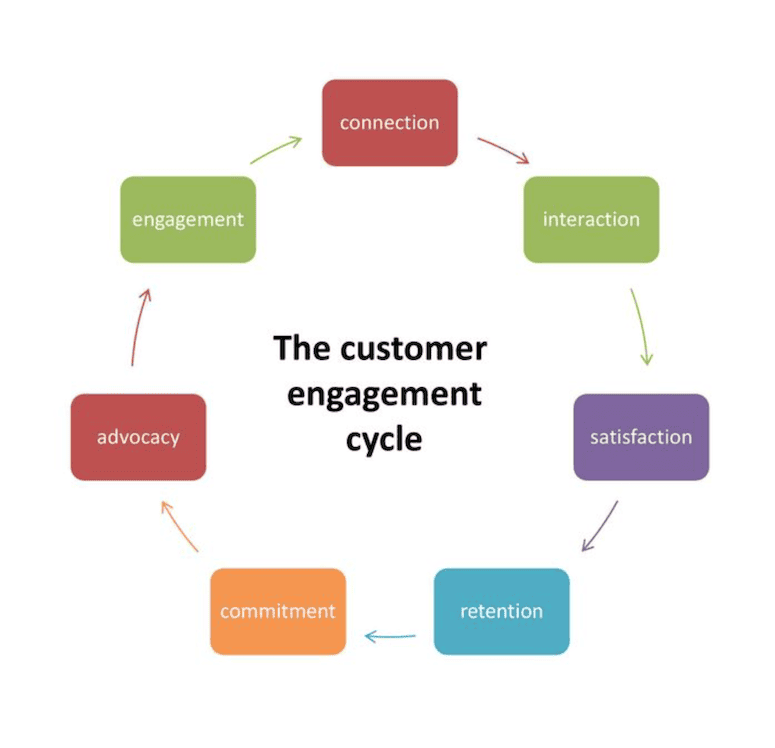Navigating the Customer Engagement Cycle in the World’s ‘Mobile-Only’ Continent: How to Reach African Customers in a Shifting Online Landscape
Customer engagement has evolved over the years: While most businesses were once purely transaction-centred (i.e., focused on acquiring more customers and making more sales), their customer interactions have gradually become more relationship-based. Nowadays, successful sales efforts aim to provide superior value to customers, to build the trust and commitment that can sustain long-term relationships. That’s why, in today’s competitive business environment, it is imperative for businesses to develop and execute on effective customer engagement cycles.
The customer engagement cycle is a cyclical relationship-building process that begins with customer acquisition and ends with a customer base that supports, purchases and promotes a business’ products. Building a solid base of engaged customers provides tremendous benefits to a business, converting customers into partners who collaborate with the business in the value-adding process, enabling it to better satisfy their needs and the needs of other customers. To accomplish this, businesses need to develop strategies that encompass the entire customer journey — instead of just focusing on acquisition and sales.
The need for businesses to refine their customer engagement strategies — especially the communication touchpoints that support them — has been driven by technological, social and market developments. Due to the internet, geographic borders have been erased, and traditional fixed costs (such as the need for a sales force, and access to storefront locations and other physical distribution channels) have been lowered, creating new business entrants and opportunities — but also causing more competition for customers and market share. Moreover, gaining customer loyalty has become more challenging due to easier access to information about competing products/retailers, and the lower cost of switching between these different options online, among other factors.
Yet though businesses around the world are increasingly aware of the importance of effective customer engagement — and the value of digital tools in sustaining these efforts — many continue to spend the majority of their marketing budgets on acquiring new customers rather than retaining and engaging existing ones. This is a common pitfall for businesses in Africa, which struggle to foster long-term customer engagement due to the complex nuances of the market. For instance, African customers are typically conscious of their mobile data usage due to high costs, leading them to toggle their phones’ internet connectivity on and off, depending on their current needs. In addition, a significant number of African mobile subscribers employ multiple SIM cards, often changing lines to access better network coverage or to take advantage of data and voice discounts offered by different telcos. Consequently, maintaining an “always-on” approach to online engagement becomes challenging.
These common behaviours make it difficult for brands to touch base with their customers, as most enterprise solutions and digital tools are tailored for online customer interaction. With statistics showing that acquiring a new customer can be five to seven times more expensive than retaining an existing one, and that fully engaged customers are worth an average of 23% more in share-of-wallet, profitability, revenue and relationship growth compared to the average customer, it’s clear that African businesses must put as much effort into the entire customer engagement cycle as they’ve traditionally put into the initial customer acquisition phase. And as Africa remains a “mobile-only” continent, with the penetration of mobile phones far outstripping fixed line usage across the region, it’s also clear that mobile technology must play an important role in these businesses’ customer engagement efforts.
Below, I’ll discuss the key elements of customer engagement, exploring how businesses can optimise these cycles to navigate the African market’s unique needs and challenges by using mobile technology to gain actionable insights into their customers’ behaviour, preferences and interests.
The Seven Elements of Customer Engagement Cycles
Customer engagement cycles have seven core elements, and African businesses must take each of them into account to develop a base of engaged customers over the long term.
Connection and Interaction: This stage is all about awareness/consideration. Africa-focused marketers need to think beyond the typical ways of segmenting audiences (e.g., dividing them by age, income levels, etc.) and also focus on acquiring a majority of customers who exhibit behaviours that are similar to those of their desired audience. For example, if a company is selling a web-based course delivered through video, it is effective to promote it via video platforms such as YouTube. The modalities are compatible, as viewers can envision themselves enrolled in the course because they are currently watching a video when they’re exposed to the ad.
With this alignment in mind, the most effective outlet for advertising in Africa is mobile phones. Customers rely on their mobile phones to conduct many of their daily activities, including e-commerce and financial transactions (powered by SMS and USSD respectively), making it particularly effective to advertise these services to customers via these mobile channels.
Satisfaction and Retention: This stage is all about the purchase of products and the follow-up support provided by the business. As with the Connection and Interaction stages, mobile phones play a key role in navigating these stages with African consumers. With mobile phones and data derived from telcos, advertisers are able to obtain key insights into their customers, using this information to make tailored product recommendations.
For instance, one insight generated by this data is that approximately 98% of African subscribers use prepaid mobile phone plans, which sheds light on the limited purchasing power of typical consumers, in contrast to the higher data usage appetites and spending capacity that postpaid plans reflect. This data can also enable advertisers to make use of “micro-moments,” in which they serve ads to customers at the exact times they know that these customers will use their devices to act on a specific need. For example, at lunch time, a person might turn to his phone to order food: If a marketer for a local restaurant serves him an ad at that exact moment, there is a higher chance of making a sale. For that reason, businesses aiming to optimise their customer satisfaction and retention efforts may find SMS text outreach to be quicker, more convenient and in some cases, more effective in engaging the African consumer — in contrast to email marketing, which may be more effective in the Global North.
Commitment, Advocacy and Engagement: In these stages of the customer engagement cycle, SMS texts can be used as an outlet to offer utilitarian, hedonic and symbolic benefits to consumers, which helps enhance and develop consumer relationships over time. Utilitarian benefits are those centred around economic savings — e.g., exclusive discounts, added convenience, gifts, etc. — and customers have been found to attach high importance to these. Hedonic benefits are where customers get individualised treatment, which could come in the form of personalised messages, entertainment options or new products geared toward their specific interests/attributes. Symbolic benefits are situations where customers are given a sense of recognition, social status or belonging by the company, for instance through special perks provided to regular customers.
Challenges and opportunities in building an effective customer engagement cycle in Africa
Service encounters and communication touchpoints are essential components of an effective customer engagement strategy in any market. In Africa, as in markets around the world, this engagement is primarily driven by the internet and digital technology, which enable brands to have conversations with customers on a constant and ongoing basis. But unfortunately, most of the digital strategies used by African businesses do not meet the specific behaviours and requirements of the African customer.
To address this, businesses must adapt their marketing efforts to the fact that people in Africa make use of their mobile phones differently than their counterparts in foreign markets. For instance, there is a prevalent use of feature phones among African consumers, which limits businesses’ ability to reach them through common digital channels like social media. Businesses must also devise solutions to customers’ tendency to switch off their mobile phone’s data to save on data charges, since this can short-circuit their attempts to establish effective customer engagement cycles in a world where customers will readily abandon a company that takes forever to reply to questions or complaints. But these customer behaviours can also generate opportunities: For example, African customers tend to check their mobile data and airtime balances often, which can provide an effective avenue to initiate the connection phase of the engagement cycle. To leverage this option, businesses can work with telcos to utilise their native channels for advertising — i.e., paying the telco to incorporate a brief personalised text ad from the business within the airtime/data balance message.
One key challenge online marketers in Africa must navigate involves the growing focus on data privacy among internet users, businesses and regulators, as initiatives by both policymakers and prominent tech companies keep making it harder for businesses to reach and consistently interact with their audiences online. For instance, the EU’s General Data Protection Regulation (among other initiatives) has created new rules protecting internet users’ data rights, and Google has announced the eradication of third party cookies — which gather information about a user’s browsing history and online activities — from Chrome by 2024. With other prominent web browsers, like Apple’s Safari and Mozilla’s Firefox, also progressively discontinuing their support for third-party cookies, businesses worldwide will need to discover new methods for monitoring user activities and delivering tailored communication. African businesses will also be impacted by these shifts, as the impending cookie-less world is expected to disrupt digital marketing channels, making it even more difficult for companies to acquire customers and drive revenue online.
Given these challenges, it is clear that typical strategies or enterprise solutions for customer engagement will not work — or to put it more conservatively, will soon cease to work — in Africa. To initiate an elaborate customer engagement strategy, it’s necessary for businesses to use widely adopted channels such as USSD and SMS (which facilitate communication without requiring an app or internet connection), and to leverage indigenous methods and enterprise solutions that address the continent’s specific realities.
Terragon has spent almost a decade building technology capabilities that allow businesses to merge their customers’ online and offline data, digital footprints and activities, in order to gain a better understanding of each customer, their preferences and their propensity for product uptake. This gives businesses the ability to deliver more relevant messaging to their customers, thereby enabling better efficiencies and ROI on marketing spend.
One of our proprietary technologies, Adrenaline, leverages artificial intelligence and machine learning to accurately segment customers and enable personalised engagement with them through the entire engagement cycle. Through partnerships with leading telcos, we’ve established the platform as Africa’s first telco-data monetisation solution, empowering advertisers to access valuable marketing insights directly from telcos, rather than from the individual phones of customers themselves. By enabling targeted mobile advertising on both web and non-web channels, Adrenaline makes it possible for brands to programmatically reach and engage with 130 million+ customers in the mobile-first African market. This reach goes beyond online channels, which are hindered by the aforementioned challenges, allowing brands that use Adrenaline to engage customers directly through always-on offline channels like SMS, flash messages and USSD.
Using this approach, the platform is helping businesses market their products and services to consumers via personalised messaging at scale, delivering promotions, order notifications, and information about new products and loyalty programs directly through these channels. Importantly in Africa, this outreach can happen even if customers’ phone data is disabled. Marketers can also use Adrenaline to gain real-time customer feedback through smart surveys, and make use of the platform’s reward engine, which delivers virtual rewards to loyal customers, increasing customer engagement.
Reaching African consumers in a shifting online landscape
The future of advertising in Africa, particularly in a cookie-less world, is expected to shift towards more privacy-focused and contextual advertising approaches. Without third-party cookies tracking internet users’ identity and behaviour online, advertisers in Africa and around the world will need to find new ways to deliver targeted ads to their audiences. As eMarketer reported, 60% of U.S. marketers believe they’ll need multiple identity solutions to survive in a post-cookie world, and solutions such as Adrenaline, which uses data from telcos and other sources, are likely to be the answer.
Another potential solution is contextual advertising, which targets users based on the content they are currently consuming rather than their browsing history. This approach has already gained popularity in Africa, and it is expected to continue to grow in the absence of third-party cookies. First-party data — i.e., data that is collected directly from users through their interactions with a business or website — can also offer a solution. By collecting and analysing this data, businesses can better understand their audience and deliver more personalised and relevant ads. This approach requires a strong focus on user privacy and data protection, which is becoming increasingly important in Africa and globally.
Whatever the solution, it’s clear that in today’s African market, the traditional marketing strategies of the past will no longer be an effective means to engage customers — and neither will solutions copy-and-pasted from foreign markets. Africa-focused marketers need to contemplate the use of customer engagement strategies that meet the market where it’s at. By recognising how African customers engage with brands, and reaching them through the mobile devices and media platforms they’re most comfortable with, marketers can not only engage customers effectively, they can also create lasting relationships with them. If they don’t, they may find themselves gradually losing relevance to the core customers that drive their businesses.
Ayodeji Balogun is Chief Technology Officer at Terragon.
Photo courtesy of Francisco Venâncio.
- Categories
- Technology



